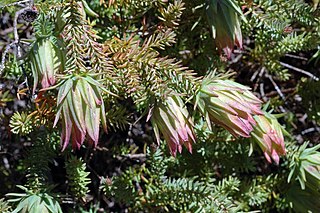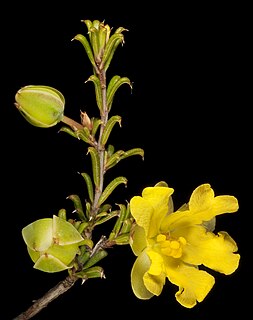
Thomasia sarotes is a flowering plant in the family Malvaceae. It is an upright, spreading shrub with white, pinkish or purple flowers and is endemic to the south-west of Western Australia.

Geleznowia is a monotypic genus of a flowering plant in the family Rutaceae. It is a small shrub with oval-shaped leaves, yellow flowers and is endemic to Western Australia. Its only species is Geleznowia verrucosa.

Eucalyptus uncinata, commonly known as the hook-leaved mallee, is a species of mallee that is endemic to the southwest of Western Australia. It has smooth bark, lance-shaped adult leaves, flower buds arranged in groups of nine to thirteen, creamy white flowers and barrel-shaped to oval or cylindrical fruit.

Darwinia oederoides is a species of flowering plant in the family Myrtaceae and is endemic to the south-west of Western Australia. It is a low, spreading shrub with linear leaves and clusters of pendent flowers surrounded by red and yellow bracts.

Thryptomene mucronulata is a species of flowering plant in the family Myrtaceae and is endemic to Western Australia. It is an erect shrub with upward-pointing, overlapping, egg-shaped leaves with the narrower end towards the base and pink flowers with five petals and ten stamens.

Boronia pulchella, commonly known as the pink boronia, is a plant in the citrus family Rutaceae, and is endemic to a small area in the south-west of Western Australia. It is a slender shrub with rod-like stems, pinnate leaves and deep pink, four-petalled flowers.
Pultenaea brachyphylla is a species of flowering plant in the family Fabaceae and is endemic to the south of Western Australia. It is an erect, spindly shrub with cylindrical, grooved leaves and yellow, orange and brown flowers.
Gompholobium obcordatum is a species of flowering plant in the family Fabaceae and is endemic to the south-west of Western Australia. It is an erect, open shrub with heart-shaped leaves, the narrower end towards the base, and uniformly yellow, pea-like flowers.
Pultenaea rotundifolia is a species of flowering plant in the family Fabaceae and is endemic to the south of Western Australia. It is a straggling, spreading shrub with flat, glabrous leaves, and yellow flowers with red markings.

Hibbertia rostellata is a species of flowering plant in the family Dilleniaceae and is endemic to the south-west of Western Australia. It is a low, straggling or erect shrub that typically grows to a height of 15–50 cm (5.9–19.7 in) and flowers between August and November producing yellow flowers. It was first formally described in 1849 by Nikolai Turczaninow in the Bulletin de la Société Impériale des Naturalistes de Moscou. The specific epithet (rostellata) means "possessing a small beak or snout", referring to the tip of leaves.

Daviesia lancifolia is a species of flowering plant in the family Fabaceae and is endemic to the south-west of Western Australia. It is a prostrate to erect, spreading shrub with egg-shaped, more or less round or linear phyllodes and yellow to orange and red flowers.

Lasiopetalum rosmarinifolium is a species of flowering plant in the family Malvaceae and is endemic to the south-west of Western Australia. It is an erect or spreading shrub with hairy stems and leaves, linear leaves and white flowers.
Olearia imbricata, commonly known as imbricate daisy bush, is a species of flowering plant in the family Asteraceae and is endemic to the south-west of Western Australia. It is a shrub with small, overlapping linear leaves and bluish-purple or white, daisy-like inflorescences.

Sphaerolobium drummondii is a species of flowering plant in the family Fabaceae and is endemic to the south-west of Western Australia. It is an erect, leafless shrub with red and yellow or orange flowers from July to November.
Sphaerolobium daviesioides, commonly known as prickly globe-pea, is a species of flowering plant in the family Fabaceae and is endemic to the south of Western Australia. It is an erect, rigid, leafless shrub with orange or yellow and red flowers from August to October.

Mirbelia microphylla is a species of flowering plant in the family Fabaceae and is endemic to Western Australia. It is an erect shrub with many branches that typically grows to a height of 15–100 cm (5.9–39.4 in) and has yellow and red flowers from August to October. It was first formally described in 1853 by Nikolai Turczaninow who gave it the name ''Dichosema microphyllum in the Bulletin de la Société Impériale des Naturalistes de Moscou. In 1864, George Bentham changed the name to Mirbelia microphylla in Flora Australiensis. The specific epithet (microphylla) means "small-leaved".

Spyridium cordatum is a species of flowering plant in the family Rhamnaceae and is endemic to the south-west of Western Australia. It is a prostrate, straggling or ascending shrub with leathery, broadly heart-shaped leaves with a notched tip, 2–4 mm (0.079–0.157 in) long with woolly, white or rust-coloured hairs on the lower side. The heads of flowers are 6.5–8.5 mm (0.26–0.33 in) wide with two to four floral leaves at the base. The sepals are up to 1.6 mm (0.063 in) long the petal tube shaggy-hairy with more or less glabrous lobes.
Spyridium polycephalum is a species of flowering plant in the family Rhamnaceae and is endemic to the south of Western Australia. It is an erect shrub that typically grows to a height of 0.3–1 m and has white to cream-coloured flowers from April to November. It grows in heathlands and shrublands on coastal dunes, rocky hillsides and plains in the Avon Wheatbelt, Coolgardie, Esperance Plains and Mallee bioregions of southern Western Australia.

Thomasia brachystachys, is a flowering plant in the family Malvaceae and is endemic to Western Australia. It is a small, upright shrub with heart-shaped leaves and purple flowers.
Spyridium villosum is a species of flowering plant in the family Rhamnaceae and is endemic to the south-west of Western Australia. It is a small shrub with shaggy-hairy branchlets, linear to oblong leaves and dense heads of hairy flowers with broad brown bracts at the base.













